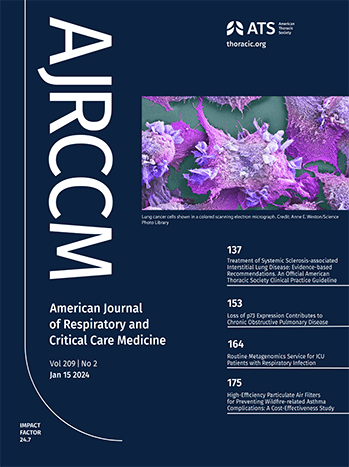进行性肺纤维化生理指标的表现特点。
IF 19.4
1区 医学
Q1 CRITICAL CARE MEDICINE
American journal of respiratory and critical care medicine
Pub Date : 2025-06-18
DOI:10.1164/rccm.202501-0317oc
引用次数: 0
摘要
已经提出了进行性肺纤维化(PPF)的临床测量方法,但其临床用途尚不清楚。目的确定基于肺功能的PPF测量的性能特征,包括区分临床相关结果的新指南标准。方法采用多中心回顾性队列分析,评估强制肺活量(FVC)和弥散量(DLCO)下降的8种分类测量方法的表现特征,以及PPF指南标准(需要以下两个标准):在美国、英国和加拿大的纤维化性ILD患者中,以呼吸系统症状恶化、FVC绝对下降≥5%或DLCO≥15%或放射学进展为鉴别2年死亡或肺移植的标准(n=2727)。使用决策曲线比较了最佳表现措施的净效益,以告知治疗开始。结果以FVC相对下降10%、DLCO相对下降15%和PPF指导标准划分的sppf整体测试效果最佳,受试者操作曲线下面积为0.67 ~ 0.68。所有评估指标的特异性高于敏感性,肺功能下降的相对指标优于绝对指标。在治疗概率阈值范围内,FVC≥10%和DLCO≥15%的独立相对下降的净收益与PPF指南标准相似。结论通过单独测量FVC和DLCO下降对PPF进行分类与PPF指南标准具有相似的临床应用价值。表现最好的基于生理的PPF测量方法具有高特异性,但灵敏度低。本文章由计算机程序翻译,如有差异,请以英文原文为准。
Performance Characteristics for Physiological Measures of Progressive Pulmonary Fibrosis.
RATIONALE
Clinical measures of progressive pulmonary fibrosis (PPF) have been proposed, but their clinical utility remains unclear.
OBJECTIVES
To determine performance characteristics of lung function-based PPF measures, including new guideline criteria for discriminating clinically relevant outcomes.
METHODS
A multicenter retrospective cohort analysis was performed to assess the performance characteristics of eight categorical measures of forced vital capacity (FVC) and diffusion capacity (DLCO) decline, along with PPF guideline criteria (requiring two of the following: worsening respiratory symptoms, absolute decline in FVC ≥5% or DLCO ≥15%, or radiological progression) for discriminating two-year death or lung transplant among fibrotic ILD patients from the United States, United Kingdom and Canada (n=2727). The net benefit of the top performing measures to inform treatment initiation were compared using decision curves.
RESULTS
PPF classified according to relative decline in FVC of 10%, relative decline in DLCO of 15% and PPF guideline criteria displayed best overall test performance, with area under the receiver operator curves of 0.67-0.68. Specificity was higher than sensitivity for all evaluated measures, with relative measures of lung function decline outperforming absolute measures. The net benefit of stand-alone relative decline in FVC ≥10% and DLCO ≥15% was similar to PPF guideline criteria across the range of treatment probability thresholds.
CONCLUSION
Classifying PPF by stand-alone measures of FVC and DLCO decline provides similar clinical utility as PPF guideline criteria. Top performing physiology-based measures of PPF discriminate outcomes with high specificity, but low sensitivity.
求助全文
通过发布文献求助,成功后即可免费获取论文全文。
去求助
来源期刊
CiteScore
27.30
自引率
4.50%
发文量
1313
审稿时长
3-6 weeks
期刊介绍:
The American Journal of Respiratory and Critical Care Medicine focuses on human biology and disease, as well as animal studies that contribute to the understanding of pathophysiology and treatment of diseases that affect the respiratory system and critically ill patients. Papers that are solely or predominantly based in cell and molecular biology are published in the companion journal, the American Journal of Respiratory Cell and Molecular Biology. The Journal also seeks to publish clinical trials and outstanding review articles on areas of interest in several forms. The State-of-the-Art review is a treatise usually covering a broad field that brings bench research to the bedside. Shorter reviews are published as Critical Care Perspectives or Pulmonary Perspectives. These are generally focused on a more limited area and advance a concerted opinion about care for a specific process. Concise Clinical Reviews provide an evidence-based synthesis of the literature pertaining to topics of fundamental importance to the practice of pulmonary, critical care, and sleep medicine. Images providing advances or unusual contributions to the field are published as Images in Pulmonary, Critical Care, Sleep Medicine and the Sciences.
A recent trend and future direction of the Journal has been to include debates of a topical nature on issues of importance in pulmonary and critical care medicine and to the membership of the American Thoracic Society. Other recent changes have included encompassing works from the field of critical care medicine and the extension of the editorial governing of journal policy to colleagues outside of the United States of America. The focus and direction of the Journal is to establish an international forum for state-of-the-art respiratory and critical care medicine.

 求助内容:
求助内容: 应助结果提醒方式:
应助结果提醒方式:


